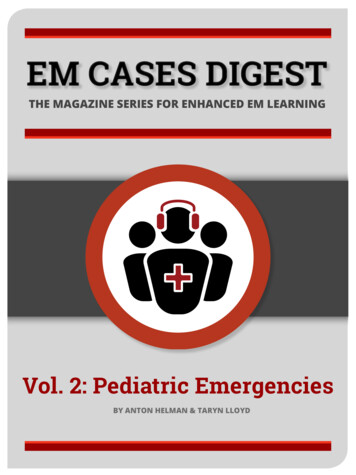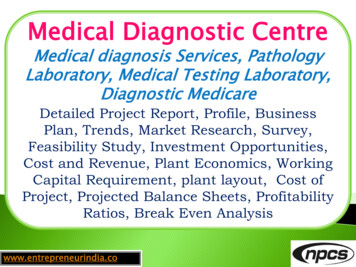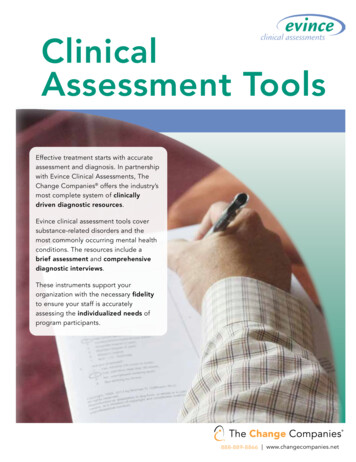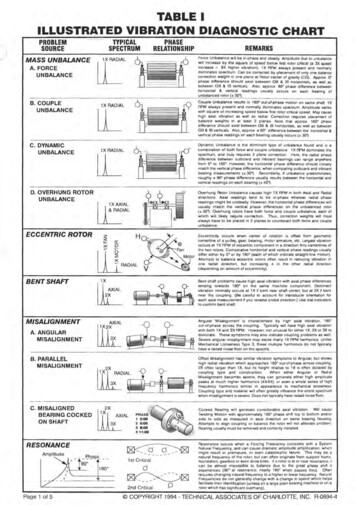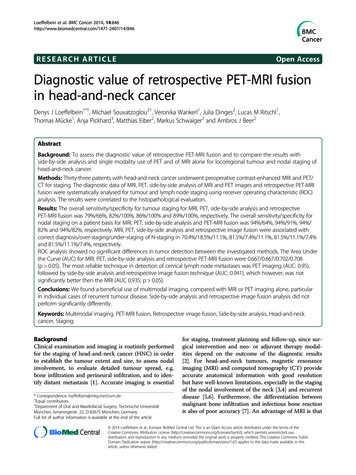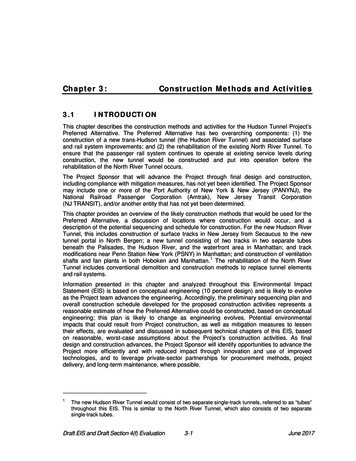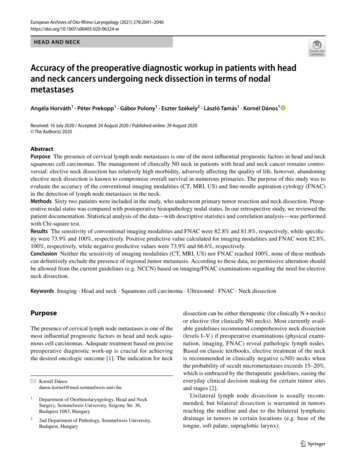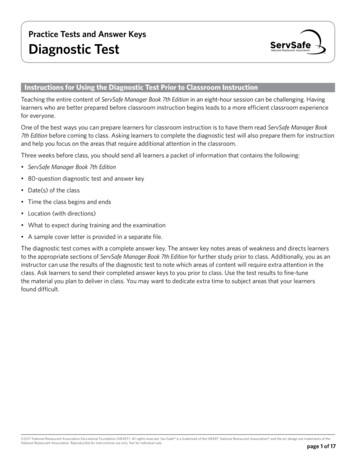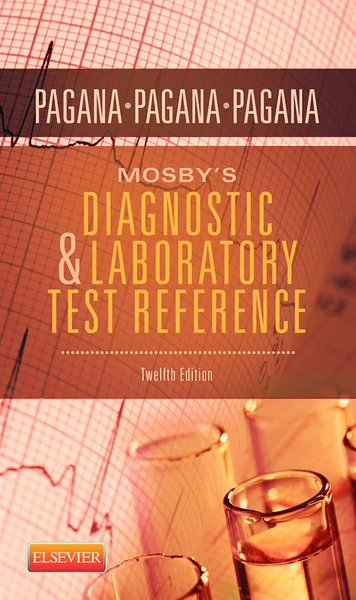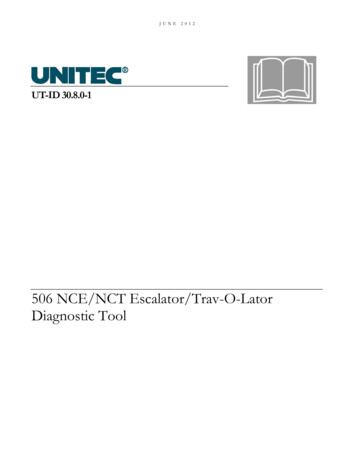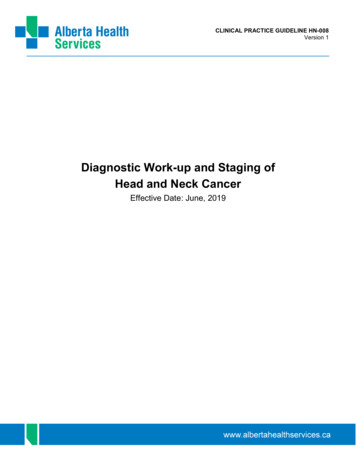
Transcription
CLINICAL PRACTICE GUIDELINE HN-008Version 1Diagnostic Work-up and Staging ofHead and Neck CancerEffective Date: June, 2019
CLINICAL PRACTICE GUIDELINE HN-008Version 1Copyright (2019) Alberta Health ServicesThis material is protected by Canadian and other international copyright laws. All rights reserved. This material maynot be copied, published, distributed or reproduced in any way in whole or in part without the express writtenpermission of Alberta Health Services (please contact the Guideline Resource Unit Manager at CancerControlAlberta at guru@ahs.ca).This material is intended for general information only and is provided on an "as is", "whereis" basis. Although reasonable efforts were made to confirm the accuracy of the information, Alberta Health Servicesdoes not make any representation or warranty, express, implied or statutory, as to the accuracy, reliability,completeness, applicability or fitness for a particular purpose of such information. This material is not a substitute forthe advice of a qualified health professional. Alberta Health Services expressly disclaims all liability for the use ofthese materials, and for any claims, actions, demands or suits arising from such use.The recommendations contained in this guideline are a consensus of the Alberta Provincial Head/Neck TumourTeam and are a synthesis of currently accepted approaches to management, derived from a review of relevantscientific literature. Clinicians applying these guidelines should, in consultation with the patient, use independentmedical judgment in the context of individual clinical circumstances to direct care.All cancer drugs described in the guidelines are funded in accordance with the Outpatient Cancer Drug BenefitProgram, at no charge, to eligible residents of Alberta, unless otherwise explicitly stated. For a complete list offunded drugs, specific indications, and approved prescribers, please refer to theOutpatient Cancer Drug Benefit Program Master List.Participation of members of the Alberta Provincial Head/Neck Tumour Team in the development of this guideline hasbeen voluntary and the authors have not been remunerated for their contributions. There was no direct industryinvolvement in the development or dissemination of this guideline. CancerControl Alberta recognizes that althoughindustry support of research, education and other areas is necessary in order to advance patient care, such supportmay lead to potential conflicts of interest. Some members of the Alberta Provincial Head/Neck Tumour Team areinvolved in research funded by industry or have other such potential conflicts of interest. However the developers ofthis guideline are satisfied it was developed in an unbiased manner.Page 2 of 12
CLINICAL PRACTICE GUIDELINE HN-008Version 1BACKGROUNDHead and neck cancer includes a variety of tumours that originate in the oral cavity, pharynx, larynx, nasalcavity, paranasal sinuses, thyroid, and salivary glands. Worldwide, it represents the 6th most commontype of cancer and accounts for about 6% of all cancers. Smoking, alcohol, age and sex are some of themost common factors for the development of head and neck cancer1.Head and neck cancers are considered among the most complex types of cancers where treatmentdecisions are made by a multidisciplinary team which includes both oncologists and allied health careprofessionals such as dietitians, dentists, and speech-language pathologists2. The initial evaluation ofpatient tumour is the most critical step for treating the cancer; it provides information that is essential tomaking decision on optimal treatment plans. The initial assessment includes indirect mirror and directendoscopy however the advanced assessment is done by imaging and biopsies. Imaging tools (CT, MRI,PET or PET/CT) are important for determining the local infiltration, regional spread, distant metastases orsecond primary tumours.The purpose of this guideline is to outline the diagnosis, and staging recommendations for patients withhead and neck cancer in Alberta.GUIDELINE QUESTIONS1. What are the diagnostic investigation and recommendations for patients with Head and Neck cancer?2. What is the clinical impact of different imaging tools on management of patients with Head and Neckcancer?3. What are the diagnostic criteria for biopsy and panendoscopy?DEVELOPMENT AND REVISION HISTORYThis guideline was reviewed and endorsed by the Alberta Head/Neck Tumour Team. Members of theAlberta Head/NeckTumour Team include otolaryngology – head and neck surgeons, reconstructivesurgeons, dentists and oral surgeons, radiation oncologists, medical oncologists, nurses, pathologists, andpharmacists. Evidence was selected and reviewed by a working group comprised of members from theAlberta Head/Neck Tumour Team and a Knowledge Management Specialist from the Guideline ResourceUnit. A detailed description of the methodology followed during the guideline development process can befound in the Guideline Resource Unit Handbook.This guideline was originally developed in 2019.SEARCH STRATEGYThe National Guideline Clearinghouse (NGC, Agency for Healthcare Research and Quality,www.guideline.gov) and individual cancer agencies’ websites were searched for clinical practiceguidelines related to Workup and staging for Head and Neck cancer. A systematic literature review wasperformed by using the Pubmed, EMBASE, and MEDLINE databases. The detailed literature searchstrategy is outlined in Appendix A, and the evidence tables are available upon request.Page 3 of 12
CLINICAL PRACTICE GUIDELINE HN-008Version 1TARGET POPULATIONThe recommendations outlined in this guideline are intended for adults over the age of 18 years withsuspected malignancies arising in the mucosal surfaces of the upper aerodigestive tract, including the oralcavity, pharynx, larynx, and paranasal sinuses. Different principles may apply to pediatric patients orpatients with thyroid/salivary gland pathology.RECOMMENDATIONSThe following recommendations should be applied in the context of the recommendations outlined in theAlberta Health Services guideline, ‘The Organization and Delivery of Healthcare Services for Head andNeck Cancer Patients.’Initial Assessment by Primary Care Physicians and Dental PractitionersFactors that Increase the Risk of Head and Neck CancerThe following factors have been shown to increase the risk of head and neck cancer: Geography (i.e. Southeast Asia) Smoking (including chewing tobacco, betel nut, paan, pituri) Alcohol consumption Age (over 40 years) Sex (male) HPV exposure (orogenital) UV / sunlight for mucosa (red portion) of lipRecommendationsHistory:1. The following signs/symptoms should be considered highly suspicious for head and neck cancer,especially if there is more than 1 symptom, persisting for more than 3 weeks: Neck lump Change in voice, usually persistent hoarseness Non-healing oral lesions-mass or ulcer Dysphagia for solids Persistent sore throat, particularly if associated with otalgia Unusual/persistent oral bleeding or epistaxis Other non-specific features, including numbness of the tongue, or other areas of the mouth,and swelling of the jaws2. Associated risk factors should be inquired about and documented.3. Inquire about HPV vaccination history.Page 4 of 12
CLINICAL PRACTICE GUIDELINE HN-008Version 1Physical Exam:4. Physical examination should include: inspection of the neck for lymph nodes, inspection of the facialand scalp skin; inspection of the oral cavity for ulceration of mucosa, swellings, and red or whitepatches and inspection of the anterior nasal cavities.Referral to Specialist:5. For ulcerative lesions or masses that are initially treated as potential infections, or bleeding nasallesions that are treated with moisturizing ointments and humidification, establish time limit for follow-upto ensure early referral for specialty care (i.e. if lesion is not resolved or dramatically improved after 3weeks of therapy, refer for urgent specialty review).Workup at Cancer CentreGeneral6. Once biopsy proven head and neck cancer identified, newly diagnosed cases should be referred to anappropriate head and neck oncologist (with affiliations to a regional cancer centre) to develop anappropriate treatment plan as soon as possible.7. All patients should undergo tumour classification and staging prior to treatment. Staging of head andneck cancers are usually based on two classifications, namely cTNM and pTNM described in detail inthe 8th edition of the AJCC Cancer Staging Manual.8. A complete head and neck examination should be completed and documented (i.e. nose, post-nasalspace, oral cavity, oropharynx, larynx and hypopharynx, including palpation of neck, oral cavity andtongue base, using endoscopy as appropriate).9. When feasible, radiological investigations should be performed prior to biopsy to avoid the effect ofupstaging from the edema caused by biopsy.10. When examination under general anesthesia including endoscopy and biopsy is indicated, thatprocedure should be performed by the surgeon who is responsible for any future proceduresImagingCT Scan:11. In all cases, CT of the neck with contrast is recommended for locoregional staging. If tumour extent isunclear on CT, and if clarification would alter management, then further evaluation with MRI isrecommended.MRI Scan:12. MRI may be particularly helpful for assessing infiltration of surrounding soft tissues (e.g. extrinsictongue muscles, parapharyngeal space, and masticator space), perineural spread, and intracranial/intraorbital extension.Page 5 of 12
CLINICAL PRACTICE GUIDELINE HN-008Version 1FDG-PET Scan:13. If nodal status is unclear on CT ( /- MRI), and if clarification would alter management, then furtherevaluation with FDG-PET is recommended.14. In a patient with an unknown primary site of tumour after head and neck examination and CT ( /MRI), FDG-PET should be performed prior to panendoscopy and biopsy so that sites of biopsy will notlead to a false-positive.15. Chest imaging is recommended for all newly diagnosed head and neck cancers to detect lungmetastases and synchronous lung cancers. Both chest CT and PET-CT are superior to chest x-ray indetecting synchronous primary cancers and distant metastases3. In cases of N2-N3 disease, patientswith a history of smoking and those otherwise at higher risk for second primary tumours and distantmetastases (supraglottic and hypopharyngeal cancer), CT of the chest or PET-CT is stronglyrecommended3,4.16. In cases of stage III-IV disease, FDG-PET should be considered for screening for distant metastasesand second primary cancers3. Interpretation should consider the relatively high false positive rate withPET-CT and the possible need for confirmatory diagnostic tests5.Diagnostic Biopsy17. It is essential that mucosal lesions of the oral cavity, oropharynx, nasopharynx, hypopharynx andlarynx that are clinically suspicious for malignancy, primarily squamous cell carcinoma, beappropriately and adequately biopsied in an expedited manner. The approach and method of biopsyare dependent on the site and size of the lesion, the level of suspicion of malignancy, the resourcesavailable and experience of the clinician.18. Oral lesions over 2 cm in maximum dimension, highly suspicious oral lesions and ulcerated or clearlyinvasive oral lesions should be sampled with an incisional or punch biopsy. The biopsy site should notbe in a necrotic or friable area. Generally, a biopsy near the edge of the tumour is ideal. A 4-mmdermatologic punch is a good choice, but scalpel blades or cupped biopsy forceps are acceptable. Thebiopsy needs to be adequately deep to allow determination of depth of invasion. Excisional biopsies ofinvasive cancers have a high incidence (62%) of leaving residual cancer requiring repeat excision6.This may complicate management but probably does not compromise overall disease control orsurvival if subsequently appropriately managed. It is suggested that excisional biopsies be reserved forsmall, superficial lesions that are thought to be benign7.19. Incisional biopsies of areas of oral leukoplakia risk false negative results of up to 24-73% in someseries mostly due to sampling errors8. Small areas of leukoplakia without worrisome clinical featurescan be excised under local anesthesia. Excisional biopsies of larger or suspicious areas of leukoplakiashould be performed under general anesthesia with adequate margins.20. All suspicious lesions of the pharynx and supraglottic larynx require biopsies with forceps. Accessiblelesions of the soft palate and tonsils may be biopsied transorally without endoscopy. Suspiciouslesions of the nasopharynx, oropharynx (base of tongue), hypopharynx and supraglottic larynx may bebiopsied using topical anesthesia and endoscopic guidance (rigid or flexible). This requires theappropriate patient positioning, endoscopes, an experienced Otolaryngologist - Head and NeckPage 6 of 12
CLINICAL PRACTICE GUIDELINE HN-008Version 1Surgeon and often a skilled assistant9. When these conditions cannot be met then traditional biopsyunder general anesthesia via rigid endoscopy is required.21. Suspected lesions of the tonsils are best sampled by way of an excision of the entire tonsil or tonsilsunder general anesthesia (diagnostic tonsillectomy). Blind biopsies of the tonsil have a very high falsenegative rate as cancers often arise deep in the tonsillar crypts and are missed unless they ulceratethrough the surface10. These tonsillectomies are often done in conjunction with a panendoscopy in thesetting of metastatic SCCA in a cervical node without an obvious mucosal lesion on office examination.Larger, ulcerated and clinically obvious cancers of the tonsil may be biopsied with forceps in the clinic.22. For biopsies of the glottis, in most cases, assessment and biopsy under general anesthesia using rigidlaryngoscopes is required (suspension laryngoscopy). Larger lesions may be biopsied withoutmagnification however early T1 cancers, leukoplakia, benign or indeterminate lesions of the glottisusually require adjuvant use of a microscope (suspension microlaryngoscopy). Larger or deeplyinvasive lesions are sampled with cupped laryngeal forceps. Superficial, benign and indeterminatelesions such as leukoplakia and erythroplasia may be suitable for excisional biopsy using either sharp“cold” instruments or a CO2 laser. Endoscopic biopsies of the glottis may sometimes be performed inclinic in selected patients by sub-specialist laryngologists in a highly specialized setting (regional voiceclinic). Sensitivity and negative predictive values for in office biopsy techniques are reported from 60 –78% and 74 – 87%, respectively.11-13. Lesions involving the anterior commissure of the glottis, bilateralvocal cords or vocal process of the vocal cord should not be excised without prior pathologicalconfirmation and multidisciplinary consultation at a regional cancer centre with discussion of alternativenon-surgical options. In performing excisional biopsies of suitable glottic lesions, care must be taken tonot violate the vocal ligament or anterior commissure regardless of the instrument used.23. Panendoscopy as a diagnostic tool for the identification of synchronous tumours is inferior incomparison to CT or PET-CT in most cases14-16. Patients at low risk of a secondary lesion have a verylow rate of synchronous tumours identified on routine pandendoscopy and esophagoscopy14,15,17,18Cancers of the hypopharynx may be an exception in that the incidence of esophageal secondprimaries is higher and esophagoscopy compares favourably to CT chest4.24. Panendoscopy is a useful tool in the workup of patients planned for surgery or potential transoralexcision of a head and neck cancer to evaluate feasibility and anatomy.Occult Primary25. Fine Needle aspiration cytology of a neck mass or neck node should be performed for occult primaries.When the FNA is non-diagnostic an open biopsy may be required. Special stains including those forlymphoma, EBV and HPV testing should be ordered to help establish the primary tumour.26. PET-CT imaging is superior to panendoscopy in the identification of an occult primary and should bethe initial investigation to establish the primary tumour. The PET-CT results may direct subsequentconfirmatory biopsies. If PET-CT fails to detect a primary tumour, the patient should be sent forpanendoscopy (EUA) for random directed biopsies of potential primary sites including tonsillectomy.27. The role of total mucosal resection for identification of unknown primaries is currently unclear.Page 7 of 12
CLINICAL PRACTICE GUIDELINE HN-008Version 1Table 1. Roles of Health Care Providers in the Diagnostic Workup and Staging of Head/Neck 2021222324252627symptoms and signsrisk factorsHPV vaccinationphysical examinationfollow-up and referralRegional Cancer Centretumour classification/AJCC stagingcomplete H&N examimaging before biopsyEUA by primary surgeonCT neck with contrastMRI as requiredPET for nodal statusPET for PUK (unknown primary)chest imaging (CT or PET-CT)PET for stage III/IVbiopsy appropriatelypunch or incisional biopsyexcisional biopsy of leukoplakiabiopsy of larynx/pharynxdiagnostic tonsillectomybiopsy of glottic lesionssynchronous cancerspre-surgery endoscopynode biopsy in PUKPET for PUK (occult primary)role of mucosal resection in PUKPrimary CareSecondary CareTertiary CareFamily Physicians &DentistsCommunity ENT &Community OMFSRegional Head/NeckCore Team Members Page 8 of 12
CLINICAL PRACTICE GUIDELINE HN-008Version 1GLOSSARY OF ABBREVIATIONSAcronymDescriptionAJCCCTEBVAmerican Joint Committee on CancerComputed TomographyEpstein-Barr VirusENTEUAFDG-PETFNAHPVMRIOMFSPETPUKTNMEar Nose ThroatExamination Under AnesthesiaFluorodeoxyglucose- Positron Emission TomographyFine Needle AspirationHuman Papilloma VirusMagnetic Resonance ImagingOral and Maxillofacial SurgeryPositron Emission TomographyPeripheral Ulcerative KeratitisTumour Nodes MetastasisDISSEMINATION Present the guideline at the local and provincial tumour team meetings and weekly rounds.Post the guideline on the Alberta Health Services website.Send an electronic notification of the new guideline to all members of CancerControl Alberta.MAINTENANCEA formal review of the guideline will be conducted at the Annual Provincial Meeting in 2021. If critical newevidence is brought forward before that time, however, the guideline working group members will reviseand update the document accordingly.REFERENCES1. Lo Nigro C, Denaro N, Merlotti A, Merlano M. Head and neck cancer: improving outcomes with a multidisciplinaryapproach. Cancer Manag Res 2017;9:363-371.2. Wheless SA, McKinney KA, Zanation AM. A prospective study of the clinical impact of a multidisciplinary head andneck tumor board. Otolaryngol Head Neck Surg 2010 Nov;143(5):650-654.3. Rohde M, Nielsen AL, Johansen J, Sørensen JA, Nguyen N, Diaz A, et al. Head-to-Head Comparison of Chest XRay/Head and Neck MRI, Chest CT/Head and Neck MRI, and 18F-FDG PET/CT for Detection of Distant Metastasesand Synchronous Cancer in Oral, Pharyngeal, and Laryngeal Cancer. J Nucl Med 2017 12;58(12):1919-1924.4. Kaida H, Ishibashi M, Kurata S, Uchiyama Y, Tanaka N, Abe T, et al. The utility of FDG-PET for detecting multipleprimary cancers in hypopharyngeal cancer patients. Nuklearmedizin 2009;48(5):179-184.5. Wallowy P, Diener J, Grünwald F, Kovács AF. 18F-FDG PET for detecting metastases and synchronous primarymalignancies in patients with oral and oropharyngeal cancer. Nuklearmedizin 2009;48(5):199; quiz N42.6. Bailey JS, Blanchaert RH, Ord RA. Management of oral squamous cell carcinoma treated with inadequate excisionalbiopsy. J Oral Maxillofac Surg 2001 Sep;59(9):1010; discussion 1011.Page 9 of 12
CLINICAL PRACTICE GUIDELINE HN-008Version 17. Frydrych AM, Parsons R, Threlfall T, Austin N, Davies GR, Booth D, et al. Oral cavity squamous cell carcinomasurvival by biopsy type: a cancer registry study. Aust Dent J 2010 Dec;55(4):378-384.8. Jeong W, Paik JH, Cho S, Sung M, Kim KH, Ahn S. Excisional biopsy for management of lateral tongue leukoplakia.J Oral Pathol Med 2012 May;41(5):384-388.9. Lee F, Smith KA, Chandarana S, Matthews TW, Bosch JD, Nakoneshny SC, et al. An evaluation of in-office flexiblefiber-optic biopsies for laryngopharyngeal lesions. J Otolaryngol Head Neck Surg 2018 May 09,;47(1):31.10. Waltonen JD, Ozer E, Schuller DE, Agrawal A. Tonsillectomy vs. deep tonsil biopsies in detecting occult tonsiltumors. Laryngoscope 2009 Jan;119(1):102-106.11. Richards AL, Sugumaran M, Aviv JE, Woo P, Altman KW. The utility of office-based biopsy for laryngopharyngeallesions: comparison with surgical evaluation. Laryngoscope 2015 Apr;125(4):909-912.12. Cohen JT, Safadi A, Fliss DM, Gil Z, Horowitz G. Reliability of a transnasal flexible fiberoptic in-office laryngealbiopsy. JAMA Otolaryngol Head Neck Surg 2013 Apr;139(4):341-345.13. Cha W, Yoon B, Jang JY, Lee JC, Lee BJ, Wang S, et al. Office-based biopsies for laryngeal lesions: Analysis ofconsecutive 581 cases. Laryngoscope 2016 11;126(11):2513-2519.14. Page C, Lucas-Gourdet E, Biet-Hornstein A, Strunski V. Initial staging of head and neck squamous cell carcinoma.What is the place of bronchoscopy and upper GI endoscopy? Eur Arch Otorhinolaryngol 2015 Mar;272(3):705-709.15. Kerawala CJ, Bisase B, Lee J. Panendoscopy and simultaneous primary tumours in patients presenting with earlycarcinoma of the mobile tongue. Br J Oral Maxillofac Surg 2009 Jul;47(5):363-365.16. Hung S, Tsai M, Liu T, Lin H, Chung S. Routine endoscopy for esophageal cancer is suggestive for patients withoral, oropharyngeal and hypopharyngeal cancer. PLoS ONE 2013;8(8):e72097.17. Koo K, Harris R, Wiesenfeld D, Iseli TA. A role for panendoscopy? Second primary tumour in early stage squamouscell carcinoma of the oral tongue. J Laryngol Otol 2015 Jan;129 Suppl 1:27.18. Kesting MR, Robitzky L, Al-Benna S, Steinstraesser L, Baurecht H, Wolff K, et al. Bronchoscopy screening inprimary oral squamous cell carcinoma: a 10-year experience. Br J Oral Maxillofac Surg 2009 Jun;47(4):279-283.Page 10 of 12
CLINICAL PRACTICE GUIDELINE HN-008Version 1APPENDIX A: Literature Search StrategySearchBiopsiesFNA,IHCDatabaseDatePubMedAug 29Search Strategy(((("biopsy"[MeSH Terms] OR "biopsy, fine-needle"[MeSHTerms]) OR "incisional biopsy"[All Fields]) OR "excisionalbiopsy"[All Fields]) AND ("early diagnosis"[MeSH Terms]OR "early detection of cancer"[MeSH Terms])) AND ("headand neck neoplasms"[MeSH Terms] NOT "thyroidneoplasms"[MeSH Terms])(("immunohistochemistry"[MeSH Terms] AND (("earlydiagnosis"[MeSH Terms] OR "early detection ofcancer"[MeSH Terms]) AND (("head and neckneoplasms"[MeSH Terms] NOT "thyroid neoplasms"[MeSHTerms])("fine-needle aspiration"[All Fields] AND "head and neckcancer"[All Fields]) AND xcisionalPubMedAug 30((("early diagnosis"[MeSH Terms] OR ("early"[All Fields]AND "diagnosis"[All Fields]) OR "early diagnosis"[AllFields]) OR ("early detection of cancer"[MeSH Terms] OR("early"[All Fields] AND "detection"[All Fields] AND"cancer"[All Fields]) OR "early detection of cancer"[AllFields])) AND ("head and neck neoplasms"[MeSH Terms]NOT "thyroid neoplasms"[MeSH Terms])) AND "epsteinbarr virus infections"[MeSH Terms](("early diagnosis"[MeSH Terms] OR "early detection ofcancer"[MeSH Terms]) AND ("incisional biopsy"[All Fields]OR "excisional biopsy"[All Fields])) AND "mouthneoplasms"[MeSH Terms]LimitsResults("humans"[MeSH Terms]AND English[lang] AND"adult"[MeSH Terms])("humans"[MeSH Terms]AND English[lang] AND"adult"[MeSH Terms])82397None("humans"[MeSH Terms]AND English[lang] AND"adult"[MeSH Terms])48None7("incisional biopsy"[All Fields] OR "excisional biopsy"[AllFields]) AND "oral cancer"[All Fields]"biopsy, fine-needle"[MeSH Terms] AND ("pharyngealneoplasms"[MeSH Terms] OR "laryngeal neoplasms"[MeSHTerms])None35("humans"[MeSH Terms]AND English[lang] AND"adult"[MeSH Terms])79(("2007/08/27"[PDat] :"2017/08/24"[PDat] AND"humans"[MeSH Terms] ANDEnglish[lang] AND"adult"[MeSH Terms]))Only the following articletypes:Clinical trials, comparativestudies, controlled clinicaltrials, meta-analyses,multicenter studies,observational studies, andrandomized controlled trialsOther limits: sample sizegreater than or equal to 20175PharynxandlarynxImagingMRI/CTPubMedSept 5PubMed24 Aug((((("head and neck neoplasms"[MeSH Terms] NOT "thyroidneoplasms"[MeSH Terms]))) AND (("computerizedtomography"[MeSH Terms] OR "Magnetic resonanceimaging"[MeSH Terms]))) AND (("Diagnosis" OR"Staging")))CT T1aglottic CaPubMed5 Sep(("computerized tomography"[MeSH Terms] AND"glottis"[MeSH Terms]))0Page 11 of 12
CLINICAL PRACTICE GUIDELINE HN-008Version 1SearchPET CTDate27 AugSearch Strategy(("head and neck neoplasms"[MeSH Terms] NOT "thyroidneoplasms"[MeSH Terms])) AND "Positron EmissionTomography Computed Tomography"[MeSH Terms] AND(("Diagnosis" OR 7/08/27"[PDat] :"2017/08/24"[PDat] AND"humans"[MeSH Terms] ANDEnglish[lang] AND"adult"[MeSH Terms]))Other limits: sample sizegreater than or equal to 20;excluded comparisons of PETCT and PET-MRI6 Sep(("head and neck neoplasms"[MeSH Terms] NOT "thyroidneoplasms"[MeSH Terms]) AND Panendoscopy)45Occult PrimaryBiopsyPubMed("2007/08/27"[PDat] :"2017/09/06"[PDat] AND"humans"[MeSH Terms] ANDEnglish[lang] AND"adult"[MeSH Terms])Sept 6("biopsy"[MeSH Terms] AND ("head and neckneoplasms"[MeSH Terms] NOT "thyroid neoplasms"[MeSHTerms])) AND "neoplasms, unknown primary"[MeSHTerms]("humans"[MeSH Terms]AND English[lang] AND"adult"[MeSH Terms])467 Sep("2007/08/27"[PDat] :"2017/09/07"[PDat] AND"humans"[MeSH Terms] ANDEnglish[lang] AND"adult"[MeSH Terms])English Language, publicationyear between 2007 and 201726English Language, publicationyear between 2007 and 20170Wait TimesDatabasePubMedPubMedMedline7 Sep((wait times) AND ("head and neck neoplasms"[MeSHTerms] NOT "thyroid neoplasms"[MeSH Terms]))Keywords: Wait times AND head and neck neoplasmsCINAHL7 SepKeywords: Wait times AND head and neck neoplasmsCochrane7 SepHead and neck neoplasms wait timesEmbase7 SepKeywords: Wait times AND head and neck neoplasms532N/AEnglish Language, publicationyear between 2007 and 2017Page 12 of 12
14. In a patient with an unknown primary site of tumour after head and neck examination and CT ( /- MRI), FDG-PET should be performed prior to panendoscopy and biopsy so that sites of biopsy will not lead to a false-positive. 15. Chest imaging is recommended for
